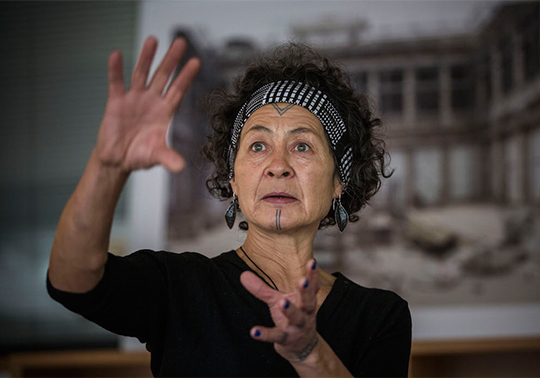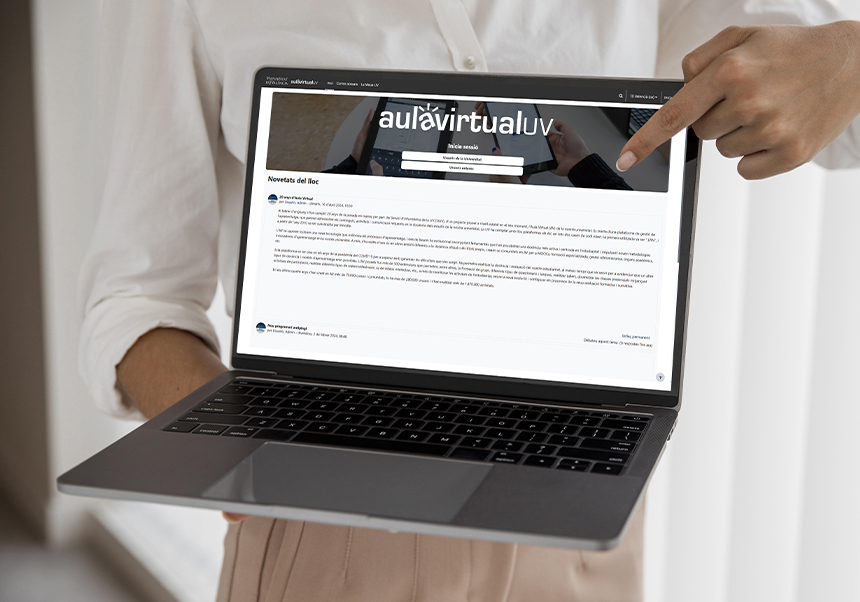Aaju Peter: “The survival of the Inuit people is practically a miracle”
- November 16th, 2016

ANNA BOLUDA. Photographs: Miguel Lorenzo. She is one of the most visible activists of the Inuit community, the people who live in the Arctic areas in four different states and who, due to the European ban on importing seal skin, are currently facing a serious problem of survival. Aaju Peter has come to the Universitat de València to do a performance in La Nau and a conference at the Institute of Human Rights with a clear objective: bring us closer to the unknown Inuit world and the challenges it is facing.
The ignorance of the rest of the world of Inuit culture (term preferred before Eskimo, which means "raw meat eaters" and has a certain pejorative charge in some countries) is flagrant. Beyond the igloos, kayaks and a peculiar way of kissing each other by rubbing their noses (which, moreover, is not true!), we know practically nothing of the inhabitants of the most northern parts of the planet. And, at the same time, “the decisions taken by the European institutions have ended with their only economic source”, explains this activist.
Aaju Peter was born in Greenland in 1960, studied in Denmark and since 1991 she lives in Iqaluit, Nunavut, in the northwest of Canada. In 2012 she received the Order of Canada, the country's highest civil award. In addition to being an activist, she is an attorney, artist, fashion designer with seal skin and recuperator of Inuit traditions. This is why she has so many tattoos in her hands and face: tattooing all over the body was a tradition of Inuit women until the Christian missionaries arrived and forbade it. Around a decade ago, some of them decided to recover this tradition.
What is the Inuit’s current situation?
Right now we are about one hundred and fifty thousand people spread across Greenland, Alaska (United States), Siberia (Russia) and Canada, where I live. In Canada, most part of the population lives in Labrador and the north of Quebec. In Nunavut, which is a very extensive territory, there are thirty-two thousand people, and in Iqaluit, my community, there are about seven thousand inhabitants. Our economy has been supported for decades by the fur trade, but because of the European ban the market is has sunk. Nor can we sell it to the United States or Russia. Hunters can no longer maintain their communities as they did historically. Right now, of all the industrialised countries, the Inuit are the ones that have the least food security: we have no income and bringing things from the outside is extremely expensive. We live in Canada, a rich country of the first world, in conditions of the third world. The situation is unsustainable and that's why I'm here; I want to explain our reality.
What is the European ban on seal products?
First of all we have to consider that nobody should forbid anything to anyone. The European ban on seal products prevents them from being sold in Europe. It includes an exception for traditional Inuit hunting, but even so, we have not been able to sell a single skin since 2009, and before that prices had already collapsed: from one hundred dollars per skin to less than ten. European legislation has ruined our only source of income. I believe that European citizens have been misled on this issue: the great anti-seal-hunting organisations, which are very powerful and have put pressure on a lot of politicians, have lied about the reality of seal hunting.
What have they lied about? What would be the solution for the Inuit?
In the 1970s, when campaigns against hunting began, there were a million and a half seals. Currently there are more than seven million: they are too many, it is not sustainable. Europe must correct the mistake it has made with this ban and allow us to hunt again. The protection of seals, based on moral concepts on animal welfare, has led to overpopulation and we are reaching a point where it can be considered as a plague. They are already negatively affecting the environment, because they consume more than ten thousand tons of fish each year. We want to hunt seals again in order to sell them, recover the industry and control their population. These days traveling through Spain, I have seen hams hanging proudly at shops and restaurants. That's what we want: to be proud of seal products. In addition to skin, seal meat is very valuable, it is very nutritious and totally natural, and we should be able to market it. This is my goal: to make Europeans understand the benefits we can get from seals. It is essential that we can recover our source of income, since without economy, all other rights that we have as an indigenous population are endangered: if we cannot maintain ourselves, we will lose culture, language, everything. At this time the survival of the Inuit is practically a miracle.
With the current lack of economic resources, how is the life of the young Inuit?
We have a large number of young people: sixty percent of our population is less than twenty-five years old. The dropout rate is seventy-five percent. One of the most serious problems we have is that there are no opportunities for those young people in our community now that we cannot hunt. Unemployment rates are very high. There is nothing we can do; it is a very complicated situation. And they do not have other place to go. Consider that we live far away, to travel we have to go by plane, we do not have roads, in my territory nor even we have port. And yet some people from our community go to college in other parts of Canada, to the south. For some of them it is hard to adapt to this life, because they come from very small towns with a very traditional life, but others achieve to get their training. Almost everyone returns to the Arctic when they finish, because life in the south is very different from ours. My children –She has five– have had the option of training in modern life and one of them, for example, is an expert in the Internet. But the problem is that they do not have the possibility of following the traditional Inuit life
Is there no other way out?
Now some people are looking to engage in mining, but it is not enough. Developing tourism is another option, which could be a good source of income. Every year we have more cruises that visit us now that the ice is melting and the Arctic is navigable, but we have to make an effort to try to benefit from this industry. We have to make people want to come to know the latest hunting culture in the world, teach them how to make igloos, make great experience out of the trip. Another option would be to bring together Inuit and European cities, so the people here could go there and vice versa. This would make it easier for them to know us, to understand us. There is a great potential in tourism, but we need resources to start it, we do not have the necessary infrastructures today.
How does climate change affect your community?
More than twenty-five years ago we began to notice the effects. I have been travelling all along the Arctic for fifteen years in tourist cruises, and I have seen that, at some points, what we call “ice that never melts” has been reduced by twenty to thirty meters, and it is happening faster every day. In addition, we need snow for commuting between communities, and now it arrives a month later and leaves a month earlier. It is affecting plants, animals and people. The union of the effects of climate change with the European ban on seal products is lethal to the Inuit.
















